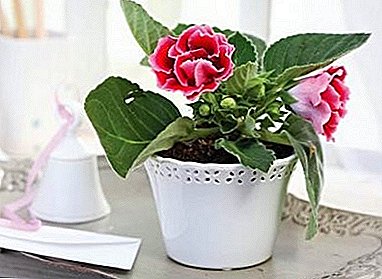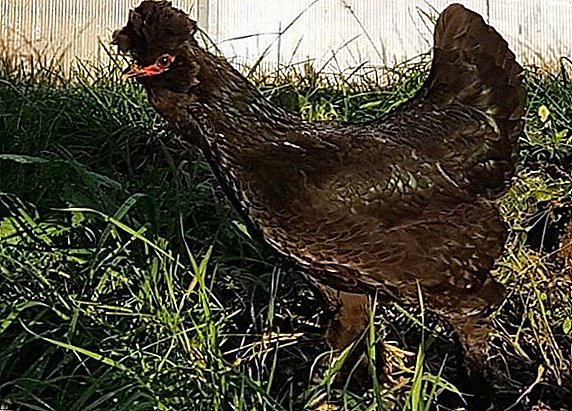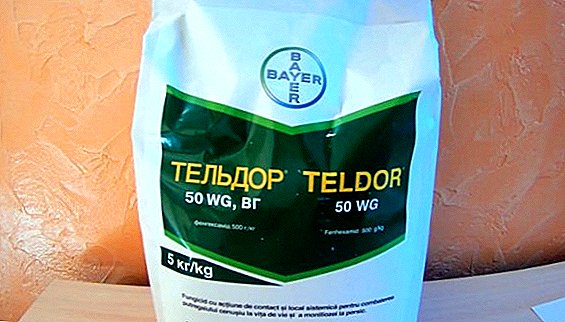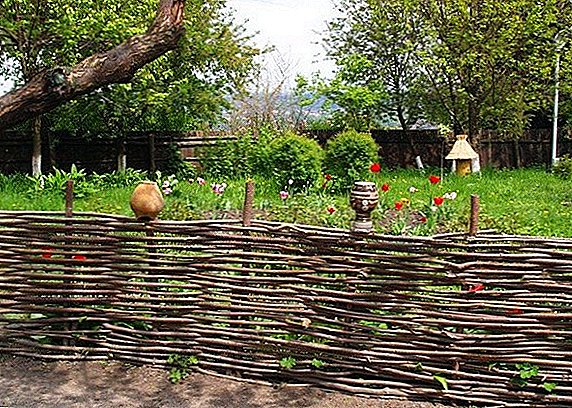
Each novice gardener inevitably raises the question of the construction of greenhouses for growing vegetables. In the open field, they simply do not have time to ripen to a usable maturity.
A joke about the "country of eternally green tomatoes" from the category of those in which there is some truth. In addition, I want early vegetables and greens. To do this, it does not hurt to learn more about the mini greenhouse on the windowsill.
In this article we will talk about frame greenhouses and improvised means for their manufacture by hand.
Choosing materials
 A huge number of firms are selling greenhouses and greenhouses, the same models can be bought from manufacturers cheaper. But many people prefer to build a greenhouse on their own.
A huge number of firms are selling greenhouses and greenhouses, the same models can be bought from manufacturers cheaper. But many people prefer to build a greenhouse on their own.
Let us consider in more detail how to make a greenhouse with your own hands at home? With the necessary materials, tools, and some skills, this is quite possible.
At the very beginning it is worth determine your financial capabilities and decide what materials will be made an important object. This applies equally to the frame of the greenhouse, and to its cover.
Choosing from a variety of options for the shape, size, layout of windows and doors in the basis of the following requirements:
- Framework for the greenhouse must be tough and durable fastenersThis allows it to withstand seasonal fluctuations in temperature, wind gusts and heavy snow cover in winter, which will invariably create an additional load on the structure;
- Must be absent or minimized massive elements, so as not to reduce illumination;
- If necessary, frequent disassembly of the greenhouse should provide a small weight of materials and ease of dismantling.
Tree
The wooden greenhouse is the most affordable, convenient and low in price. When working independently, it is easily processed without requiring special skills or additional professional equipment. It is eco-friendly, the design is easy.
But there are drawbacks, one of which is his susceptibility to rotting. Special antiseptic treatment is required, and it needs to be repeated periodically. In addition, wood materials may be affected by fungal diseases or pests.
All used means of protection against these factors should be made on an organic basis, not emit toxic substances, so as not to harm the grown crops.

If you are a supporter of environmental solutions - this is your material. It is only necessary to provide as few joints and connections as possible in the structure, which will help to avoid excessive accumulation of moisture in them.
Wooden crate should be processedotherwise it will tear the film when coated. Of course, the greenhouse constructed of valuable species of tropical trees will last for decades, but this option is so expensive that it cannot even be considered theoretically.
Made by from steel pipes greenhouses are reliable and resistant. If you choose this material, then welding skills will be very useful. But such greenhouses are installed quickly. Good pipes with galvanized surface, as well as greenhouse made of fiberglass reinforcement, their service life is longer. Although it is possible to cover steel pipes with a special compound.
Aluminum profile
 Easy and easy to use, durable. In the greenhouse frame, it provides high rigidity, the structure can withstand heavy loads.
Easy and easy to use, durable. In the greenhouse frame, it provides high rigidity, the structure can withstand heavy loads.
All the details in it are connected with a household zaklepochnik or nuts through special holes. Drilling and sawing material is easy.
Despite all the advantages, greenhouses are built from this material not so often because of the high price. And if you decide to make such a greenhouse, this will help you video.
Plastic profile
Very modern stuff. The framework turns out easy, strong, does not demand additional processing, is not exposed to rotting and corrosion. Flexible plastic to the same may take different forms, it is convenient for the construction of arched and gable roofs, as well as for greenhouses from the profile for drywall.
Plastic greenhouses are not very common, they can be seriously considered only when building compact greenhouses. Because of their lightness, they must be attached to the foundation or to the ground.
Metal pipes
Are good for the capital frame greenhouses constructed not for one decade. Reinforced metal frame of the greenhouse will require a strip foundation.
Untreated surface should be painted, pre-treated with phosphoric acid and a primer for the metal. If the profiles are galvanized, then it is necessary to process the joints and cuts.
Production of metal frames for greenhouses, see the video below.
Sometimes there are recommendations for the use in the construction of greenhouses galvanized profiles produced for interior work. Practice has shown that it is not bad for its intended use, but in buildings for a protected ground, due to the increased humidity in them, its dignity is reduced to zero. In a year rust appears from under the zinc coating, after another one or two years, the construction is only suitable for scrapping.
Metal corner
Reliable material for a solid construction. With its help it is possible to build odnoskatny, duo-pitch and any other greenhouses, except arched.
It will withstand the snow load, and the gale, and other vagaries of weather. Suitable for creating collapsible and fixed structures.
To greatly simplify the side of the greenhouse, it is better to buy perforated corners.
And to increase the life of the metal you need to make a foundation. So the greenhouse from the corner will be less in contact with the ground and be exposed to corrosion.
PVC pipes
 Particularly economical and skilled gardeners adapt the pipes thrown out after the repair of the plumbing system as a building material. Their durability is amazing, they are smooth, so they do not need pads under the film.
Particularly economical and skilled gardeners adapt the pipes thrown out after the repair of the plumbing system as a building material. Their durability is amazing, they are smooth, so they do not need pads under the film.
Flexibility allows you to build any arched shape. Greenhouses from this material, built in the spring, delight all summer and autumn, before the start of serious snowfall. The first snowdrifts on the roof push the greenhouse by its weight, and it will develop an accordion, and covering material will be damaged irrevocably.
You can, of course, build small greenhouses and greenhouses from PVC and clean them for the winter. Or with the help of props and other elements add rigidity to the structure, if you are not afraid of the extra cost of money and time. You to help our video for a great review.
Coating materials: cost and characteristics
Artificial climate in greenhouses should be comfortable. This is influenced not only by the ventilation system, irrigation and lighting, but also by the properties of the material, which
construction is covered.
 The glass used for this purpose transmits light very well, resistant to temperature changes. It has a high degree of thermal insulation, resistant to aggressive chemicals and abrasive powders.
The glass used for this purpose transmits light very well, resistant to temperature changes. It has a high degree of thermal insulation, resistant to aggressive chemicals and abrasive powders.
Wherein he has not less flaws:
- The large weight of the material requires heavy and durable structures;
- Fragility - cracking from hailstorms and large accumulations of snow.;
- Does not filter infrared rays;
- For glazing greenhouses requires a lot of time and skills of such work.
Requires a smooth thick (4 mm) glass, without tinting.
Wide frames will provide high transparency of walls and roofs, but will be more vulnerable to damage and more expensive to repair.
The film is very affordable and popular for this reason. It has a high transparency, gently diffuses the light. The disadvantages include the rapid wear of low-cost brands, the formation of condensate on the inside of greenhouses, which creates favorable conditions for the development of bacterial and fungal plant diseases.
Types of films

- The most budget - polyethylene, is presented in rolls in the form of a sleeve or a single-layer cloth. The slightest cut or gap of it quickly increases, which requires caution in the work. It is better to compact the places of contact with the frame and bends with ordinary duct tape. Serves 1-2 years.
- PVC - more expensivebut the quality is higher. It has good thermal insulation, retains about 90% of infrared radiation. With proper care will serve up to 7 years.
- Reinforced greenhouse cheap - due to the inside frame of dissimilar materials (fiberglass, polyethylene, polypropylene) is 3-4 years.
Cellular Polycarbonate
One of the most suitable modern materials for greenhouses.
When heated cellular polycarbonate is extended. Therefore, it is better to cover the greenhouse in cool weather, but not below + 10 ° C, and to have sheets overlapped. See how it is done in the video below.
Features

- The material is durable and wear-resistant, less glass weighs, the heat-insulating qualities are high;
- Good light transmission of cellular polycarbonate due to multiple refraction of sunlight. Evenly distributed light is very favorable for the development and fruiting of greenhouse plants;
- Material flexibility very convenient to cover arched and tunnel greenhouses;
- Convenient in work, easy to cut and drill;
- A well-thought-out design, reinforced with stiff ribs, will withstand hail blows, snow cover and wind.
- No need to take off for the winter.
It is best to choose polycarbonate sheets with a thickness of 5-8 mm, the life of the material of foreign production of these parameters reaches up to 20 years. The ratio of price and quality in this case is optimal. The best greenhouses made of polycarbonate, you will see this if you follow our advice.
How to make a frame for the greenhouse with your own hands?
What can this structure be made to beginner gardeners, what material is more suitable for your site? Let us examine these questions and, for example, make a greenhouse of galvanized profile.
The design of greenhouses made of polycarbonate with their own hands will be strong enough for low weight, resistant to external influences, it is permissible to install it directly on the prepared soil, it is easy to disassemble and move.
In general, it will be a cheap greenhouse, with his own hands and with a soul made, as can be seen in the photo.
Step-by-step instruction
- First, decide what the greenhouse will look like with your own hands from scrap materials. Enjoy the planning process itself, consider all the disadvantages and advantages of the land relief, and the first must be compensated, the second to use.
- Make drawings and diagrams with the desired size and shape of the frame.
- Stocking the right amount of materials and tools. You will need: rack-mount galvanized profile, guides, screws with flat caps.
- We also need a tape measure, level, screwdriver, metal scissors.
- We prepare the plot, clearing the ground from the garbage and leveling the ground.
- Place the installation mark, if necessary - we make the foundation.
- Not far from the place where the greenhouse will stand, we begin work.
- For the manufacture of racks frame we divide them into pieces of the desired length in accordance with the size of the greenhouse, length and width.
- First we assemble the base, all other elements are attached to it.
- Faceplates for greater convenience we collect together with the doorway on a flat areaand then attach to the frame

In order not to make frequent repairs, plan to immediately build a greenhouse cheaply and reliably, based on the knowledge of the disadvantages and merits of the materials you intend to use. Also, to extend the service life, you need to know how to take care of and prepare a polycarbonate greenhouse for the new season.
Each gardener has his own ideas about how his site and buildings on it will look. We can only tell from what to make a greenhouse cheap with our own hands, and also show visually.
Experiment with materials, form and principles of installation. But do not forget to approach everything carefully, having studied all the pros and cons of modern materials and technologies.












